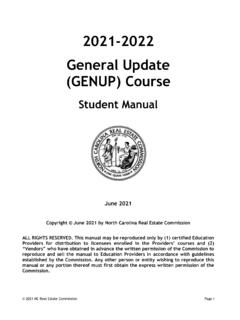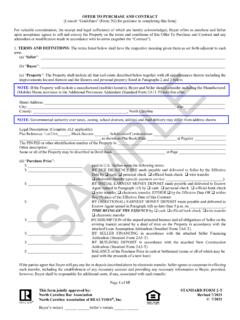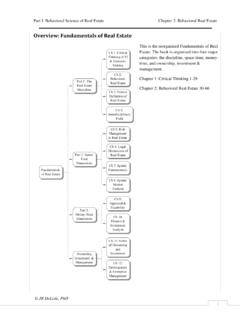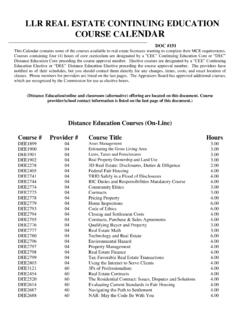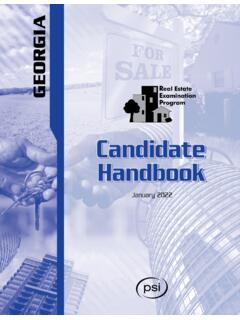Transcription of BASIC REAL ESTATE CONCEPTS - Superior School of Real …
1 CHAPTER. BASIC real ESTATE CONCEPTS 1. KEY TERMS. appurtenance indestructibility REALTOR . bill of sale land use controls realty chattel land scarcity deed nonhomogeneity situs hereditaments personal property specific performance highest and best use personalty tenements immobility real ESTATE improvements real property LEARNING OBJECTIVES. At the conclusion of this chapter, you should be able to: 1. Describe the characteristics of real ESTATE , including classes of property, physical characteristics of land, and economic characteristics of land. 2. Describe the CONCEPTS of land use and investment, including highest and best use, land use controls, investment objectives, scope of the real ESTATE business, and the real ESTATE market. IN THIS CHAPTER. This text is designed to help you master the fundamentals of real ESTATE by introducing information in a step-by-step format that requires no real ESTATE background.
2 This chapter provides an overview of the entire real ESTATE business. Each topic introduced in this chapter is discussed in more detail in the following chapters. You should use this chapter to become familiar with the format of the book, including objectives, summary of important points, and questions. Each of these sections is designed to help you study the 1. 2 CHAPTER 1 BASIC real ESTATE CONCEPTS material efficiently to master this information. Finally, this text offers advice on preparation for the North Carolina real ESTATE Licensing Examination. BASIC real ESTATE CONCEPTS . real property has certain physical and economic characteristics that set it apart from other marketable commodities. These characteristics are so interrelated that they have a definite effect on one another and are sometimes difficult to separate in a practical sense.
3 This chapter discusses these characteristics and their effects on real property value. BASIC Terminology and Definitions real ESTATE , real property, realty, and land These terms often are used inter- changeably to describe the combination of land, improvements, and rights and privileges. Title (ownership) is conveyed by deed. Personal property, personalty, or chattel Anything that is not considered to be real property. Title is conveyed by bill of sale. The first thing students will have to master in this course is the concept that all property is either real or personal. The concept of real property is made up of three components: land, improvements, and rights and privileges. (These compo- nents are addressed in more detail in the forthcoming chapters, but the following gives a brief introduction.)
4 Land The surface of the earth with the boundaries extending downward to the middle of the earth extended back upward to the highest heavens. Land consists of three components: surface, subsurface, and airspace. This concept shows us that much of what is considered land is, in fact, made up of air. In common usage, the term land often is used in much the same way as the terms real ESTATE , real property, and realty. Improvements Anything used to better or improve the use of the land. These are artificially attached items and are considered to be real property and not personal. Appurtenance Any right or privilege that is considered to run with the land. Not all rights and privileges are considered to run with the land and may be personal in nature. The concept of runs with the land is that the right or privi- lege is an integral part of the property, much like structures or other improve- ments, and are conveyed as a normal part of the deed transferring title to the real property.
5 For example, municipal water and sewer lines are an example of a right or privilege the government has to place the pipes to provide utility service to the property and likely others. When the title is conveyed to a subsequent owner, that OnCourse Learning. BASIC real ESTATE CONCEPTS 3. right remains intact. The same would apply if a property owner has the right to cross over adjoining property to access theirs. Most likely, this would be a perma- nent right that would convey upon transfer. Tenements Ownership interest in anything immobile and is considered part of the real property. Hereditaments Any rights capable of being inherited. Economic Characteristics of Land Scarcity An important economic characteristic of real property (Figure ) is its availabil- ity or scarcity. Land is a commodity that has a fixed supply base.
6 No additional physical supply of land is being produced to keep pace with the ever-increasing population. The problems created by an ever-increasing demand for the limited supply of land, however, have been eased substantially by an increase in the eco- nomic supply of land. This increase has come about as a result of the greater utili- zation of the existing physical supply of land. Farmers are continuing to increase the use of land in the agricultural area. Greater crop yields per acre are being achieved as a result of scientific and technological advances. Today, the agricul- tural industry is producing more cattle per acre and more bushels of crops per acre than it did just a few years ago. In urban areas, land is being utilized to a greater extent through high- density development.
7 Advances in science and technology result in the creation of high-rise office buildings, apartment complexes, and multilevel shopping cent- ers. Consequently, 1 acre of land serves many times the number of people who could use the land in the absence of these improvements. Modification by improvement is another factor that has increased the economic supply of land. These modifications can include the construction of highways, bridges, water reservoirs, purification plants, and public utilities. The improve- ments and expansions of public air and land transportation systems also make a significant contribution in this regard. These accomplishments in the fields of 1. Scarcity 2. Permanence of investment 3. Location FIGURE Economic characteristics of real property. Source: 2019 OnCourse Learning OnCourse Learning.
8 4 CHAPTER 1 BASIC real ESTATE CONCEPTS construction and transportation have converted land that had not been acces- sible and useful in a practical sense into land that can now be used. A substantial increase in the economic supply of land has resulted from these improvements to the land (rather than improvements on the land). Permanence of Investment Because of the physical characteristics of immobility and indestructibility of land, the investment of capital and labor to create improvements to the land and improvements on the land is a long-term investment. It takes many years to recoup the investment made to improve the value and quality of land. If a developer mis- judges the demand for land-specific improvements or if economic conditions, including real ESTATE market conditions, change dramatically, the developer may never recoup his full investment.
9 Location (Situs). The location of land, or situs, is an extremely important economic (or more pre- cisely, socioeconomic) characteristic of land, and it is the characteristic that has the greatest effect on property value. The physical characteristic of immobility dictates that the location of a parcel of land is permanent. Therefore, if the land is located in an area where demand is high, the land will have a substantially increasing value. Conversely, if the land is inaccessible from a practical stand- point or is located in an area with little or no demand, its economic value will be depressed. Although the location of land cannot be changed, the value of the location (and consequently, the value of the land) can be increased by improvements to access and other modifications. Additionally, the value of the location can change as the result of the changes in preferences of people.
10 In the 1950s there was a great flight from the urban centers to the suburbs. This resulted in property value reductions in urban areas. This trend has moderated in recent years. People are rediscovering the inner cities, rehabilitating older properties, and restoring lost urban property values. Physical Characteristics of Land Immobility An essential physical characteristic of land (Figure ) is its immobility. That land cannot be relocated from one place to another is an obvious feature of land as a commodity and is the primary distinguishing feature between land and personal property. The physical characteristic of immobility is the reason the economic characteristic of location significantly affects land value, thus making the market for land a strictly local market. This requires brokers and agents to have specific OnCourse Learning.

